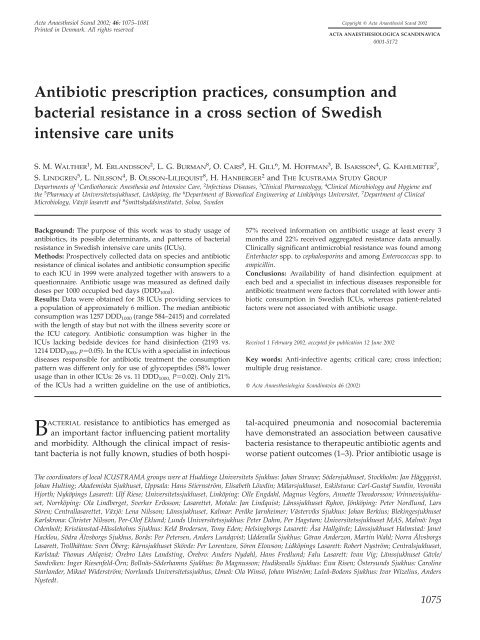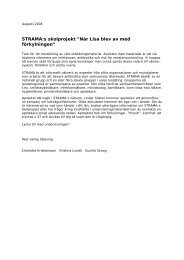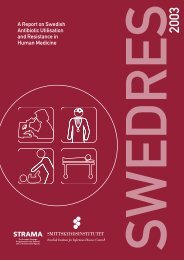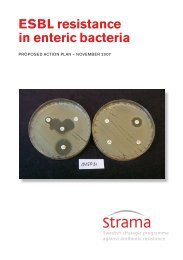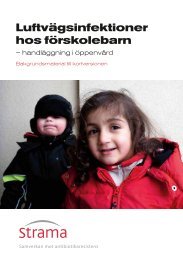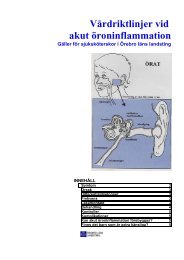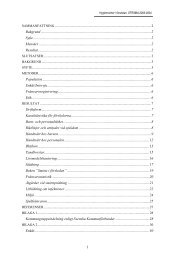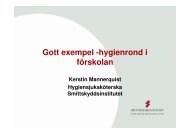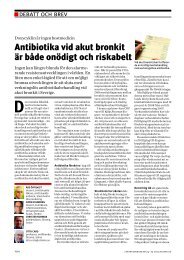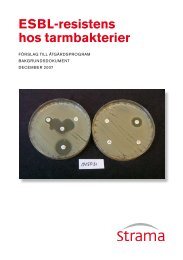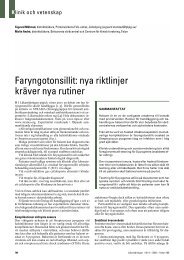Antibiotic prescription practices, consumption and ... - Snowfall
Antibiotic prescription practices, consumption and ... - Snowfall
Antibiotic prescription practices, consumption and ... - Snowfall
Create successful ePaper yourself
Turn your PDF publications into a flip-book with our unique Google optimized e-Paper software.
Acta Anaesthesiol Sc<strong>and</strong> 2002; 46: 1075–1081 Copyright C Acta Anaesthesiol Sc<strong>and</strong> 2002<br />
Printed in Denmark. All rights reserved<br />
ACTA ANAESTHESIOLOGICA SCANDINAVICA<br />
0001-5172<br />
<strong>Antibiotic</strong> <strong>prescription</strong> <strong>practices</strong>, <strong>consumption</strong> <strong>and</strong><br />
bacterial resistance in a cross section of Swedish<br />
intensive care units<br />
S. M. WALTHER 1 ,M.ERLANDSSON 2 ,L.G.BURMAN 8 ,O.CARS 8 ,H.GILL 6 ,M.HOFFMAN 3 ,B.ISAKSSON 4 ,G.KAHLMETER 7 ,<br />
S. LINDGREN 5 ,L.NILSSON 4 ,B.OLSSON-LILJEQUIST 8 ,H.HANBERGER 2 <strong>and</strong> THE ICUSTRAMA STUDY GROUP<br />
Departments of 1 Cardiothoracic Anesthesia <strong>and</strong> Intensive Care, 2 Infectious Diseases, 3 Clinical Pharmacology, 4 Clinical Microbiology <strong>and</strong> Hygiene <strong>and</strong><br />
the 5 Pharmacy at Universitetssjukhuset, Linköping, the 6 Department of Biomedical Engineering at Linköpings Universitet, 7 Department of Clinical<br />
Microbiology, Växjö lasarett <strong>and</strong> 8 Smittskyddsinstitutet, Solna, Sweden<br />
Background: The purpose of this work was to study usage of<br />
antibiotics, its possible determinants, <strong>and</strong> patterns of bacterial<br />
resistance in Swedish intensive care units (ICUs).<br />
Methods: Prospectively collected data on species <strong>and</strong> antibiotic<br />
resistance of clinical isolates <strong>and</strong> antibiotic <strong>consumption</strong> specific<br />
to each ICU in 1999 were analyzed together with answers to a<br />
questionnaire. <strong>Antibiotic</strong> usage was measured as defined daily<br />
doses per 1000 occupied bed days (DDD 1000 ).<br />
Results: Data were obtained for 38 ICUs providing services to<br />
a population of approximately 6 million. The median antibiotic<br />
<strong>consumption</strong> was 1257 DDD 1000 (range 584–2415) <strong>and</strong> correlated<br />
with the length of stay but not with the illness severity score or<br />
the ICU category. <strong>Antibiotic</strong> <strong>consumption</strong> was higher in the<br />
ICUs lacking bedside devices for h<strong>and</strong> disinfection (2193 vs.<br />
1214 DDD 1000 , pΩ0.05). In the ICUs with a specialist in infectious<br />
diseases responsible for antibiotic treatment the <strong>consumption</strong><br />
pattern was different only for use of glycopeptides (58% lower<br />
usage than in other ICUs: 26 vs. 11 DDD 1000, PΩ0.02). Only 21%<br />
of the ICUs had a written guideline on the use of antibiotics,<br />
57% received information on antibiotic usage at least every 3<br />
months <strong>and</strong> 22% received aggregated resistance data annually.<br />
Clinically significant antimicrobial resistance was found among<br />
Enterbacter spp. to cephalosporins <strong>and</strong> among Enterococcus spp. to<br />
ampicillin.<br />
Conclusions: Availability of h<strong>and</strong> disinfection equipment at<br />
each bed <strong>and</strong> a specialist in infectious diseases responsible for<br />
antibiotic treatment were factors that correlated with lower antibiotic<br />
<strong>consumption</strong> in Swedish ICUs, whereas patient-related<br />
factors were not associated with antibiotic usage.<br />
Received 1 February 2002, accepted for publication 12 June 2002<br />
Key words: Anti-infective agents; critical care; cross infection;<br />
multiple drug resistance.<br />
c Acta Anaesthesiologica Sc<strong>and</strong>inavica 46 (2002)<br />
BACTERIAL resistance to antibiotics has emerged as<br />
an important factor influencing patient mortality<br />
<strong>and</strong> morbidity. Although the clinical impact of resistant<br />
bacteria is not fully known, studies of both hospi-<br />
tal-acquired pneumonia <strong>and</strong> nosocomial bacteremia<br />
have demonstrated an association between causative<br />
bacteria resistance to therapeutic antibiotic agents <strong>and</strong><br />
worse patient outcomes (1–3). Prior antibiotic usage is<br />
The coordinators of local ICUSTRAMA groups were at Huddinge Universitets Sjukhus: Johan Struwe; Södersjukhuset, Stockholm: Jan Häggqvist,<br />
Johan Hulting; Akademiska Sjukhuset, Uppsala: Hans Stiernström, Elisabeth Löwdin; Mälarsjukhuset, Eskilstuna: Carl-Gustaf Sundin, Veronika<br />
Hjorth; Nyköpings Lasarett: Ulf Riese; Universitetssjukhuset, Linköping: Olle Engdahl, Magnus Vegfors, Annette Theodorsson; Vrinnevisjukhuset,<br />
Norrköping: Ola Lindberget, Sverker Eriksson; Lasarettet, Motala: Jan Lindquist; Länssjukhuset Ryhov, Jönköping: Peter Nordlund, Lars<br />
Sören; Centrallasarettet, Växjö: Lena Nilsson; Länssjukhuset, Kalmar: Peråke Jarnheimer; Västerviks Sjukhus: Johan Berkius; Blekingesjukhuset<br />
Karlskrona: Christer Nilsson, Per-Olof Eklund; Lunds Universitetssjukhus: Peter Dahm, Per Hagstam; Universitetssjukhuset MAS, Malmö: Inga<br />
Odenholt; Kristianstad-Hässleholms Sjukhus: Keld Brodersen, Tony Eden; Helsingborgs Lasarett: Åsa Hallgärde; Länssjukhuset Halmstad: Janet<br />
Hacklou, Södra Älvsborgs Sjukhus, Borås: Per Petersen, Anders Lundqvist; Uddevalla Sjukhus: Göran Anderzon, Martin Wahl; Norra Älvsborgs<br />
Lasarett, Trollhättan: Sven Öberg; Kärnsjukhuset Skövde: Per Lorentzen, Sören Elowson; Lidköpings Lasarett: Robert Nyström; Centralsjukhuset,<br />
Karlstad: Thomas Ahlqvist; Örebro Läns L<strong>and</strong>sting, Örebro: Anders Nydahl, Hans Fredlund; Falu Lasarett: Ivan Vig; Länssjukhuset Gävle/<br />
S<strong>and</strong>viken: Inger Riesenfeld-Örn; Bollnäs-Söderhamns Sjukhus: Bo Magnusson; Hudiksvalls Sjukhus: Ewa Risen; Östersunds Sjukhus: Caroline<br />
Starl<strong>and</strong>er, Mikael Widerström; Norrl<strong>and</strong>s Universitetssjukhus, Umeå: Ola Winsö, Johan Wiström; Luleå-Bodens Sjukhus: Ivar Wizelius, Anders<br />
Nystedt.<br />
1075
one factor that predisposes to infections with resistant<br />
bacteria (2,4,5). Frequent <strong>and</strong> extended use of antibiotics,<br />
high staffing <strong>and</strong> frequent use of invasive procedures<br />
make intensive care units (ICUs) a high-risk<br />
environment for the selection <strong>and</strong> spread of antibioticresistant<br />
bacteria. A recent consensus statement suggested<br />
that the emergence of resistance could be better<br />
controlled through optimization of prophylactic, empiric<br />
<strong>and</strong> therapeutic antibiotic use (6). This could be<br />
accomplished by education about appropriate antibiotic<br />
use <strong>and</strong> by providing data to physicians about<br />
the types <strong>and</strong> prevalence of resistant organisms found<br />
in their own institution as part of an on-going surveillance<br />
program. Tailoring of antibiotic usage to each<br />
ICU by an antibiotic management team led by an intensive<br />
care specialist was also suggested recently (7).<br />
Indeed, the utility of such a strategy was shown by a<br />
recent study in which an antibiotic management program<br />
that used local clinician-derived consensus<br />
guidelines embedded in computer-assisted decision<br />
support programs was applied in a community hospital<br />
(8).<br />
While the prevalence of resistant bacterial strains is<br />
currently favorable in Swedish ICUs compared with<br />
many other European countries (9), we believe that<br />
this could change rapidly (10). Monitoring of antibiotic<br />
usage <strong>and</strong> resistance patterns among bacteria<br />
are, in addition to prudent use of antibiotics <strong>and</strong> strict<br />
barrier nursing, key elements in the strategy to control<br />
resistance to antibiotics. Hence, the main purpose of<br />
the present multicenter study was to monitor antibiotic<br />
<strong>prescription</strong> <strong>and</strong> isolated organisms <strong>and</strong> their<br />
drug susceptibility in individual ICUs <strong>and</strong> to relate<br />
these data to clinical <strong>practices</strong> associated with the use<br />
of antibiotics <strong>and</strong> infection control measures <strong>and</strong> patient<br />
mix.<br />
Methods<br />
Questionnaires were administered by electronic mail<br />
during the year 2000 to all Swedish adult ICUs <strong>and</strong><br />
departments of infectious diseases. The questions pertained<br />
to measures that described the unit <strong>and</strong> its<br />
workload during 1999 (number of beds, number of<br />
patients, illness severity scores, length of stay, etc.)<br />
<strong>and</strong> selected infection control <strong>practices</strong>.<br />
All laboratories of clinical microbiology were contacted<br />
<strong>and</strong> asked to provide data on cultures collected<br />
on clinical indications from their matching ICUs during<br />
1999. Only initial bacterial isolates were considered<br />
<strong>and</strong> repeat isolates of the same species from<br />
the same patient were excluded. Susceptibility testing<br />
was performed at the time of sampling with a disc<br />
diffusion method according to the Swedish Reference<br />
Group of <strong>Antibiotic</strong>s (SRGA). The zone breakpoints<br />
for susceptible, intermediate <strong>and</strong> resistant strains<br />
were defined according to SRGA (11). For the purpose<br />
of this work decreased susceptibility to antibiotics<br />
was defined as the proportion of isolates with intermediate<br />
sensitivity <strong>and</strong> resistance, i.e. those separated<br />
from the normal population of isolates. In addition,<br />
hospital pharmacies were contacted <strong>and</strong> asked to provide<br />
data on deliveries of antibiotics to their corresponding<br />
ICUs during 1999. Consumption of antibiotics<br />
was assessed as the delivery of defined daily<br />
doses (DDD) per 1000 occupied bed days in the ICU<br />
(DDD 1000 ). Defined daily doses is based on the average<br />
adult maintenance dose for the primary indication<br />
of the drug <strong>and</strong> has been established by the<br />
WHO as a st<strong>and</strong>ardized basis for comparing drug<br />
<strong>consumption</strong> (12).<br />
Significance testing was not carried out to confirm<br />
hypotheses postulated a priori but to explore differences<br />
<strong>and</strong> relationships. To this end non-parametric<br />
methods (Spearman’s rank correlation, Mann–Whitney,<br />
Kruskal–Wallis <strong>and</strong> Fisher’s tests) were used.<br />
Results<br />
Responses were received from 38 ICUs providing primary<br />
services to a population of approximately 6 million.<br />
Ten units were located in tertiary care centres<br />
(regional ICUs), 20 in county hospitals (county ICUs)<br />
<strong>and</strong> eight were in local hospitals (local ICUs, Table 1).<br />
Data regarding patient flow, infection control <strong>practices</strong>,<br />
delivery of antibiotics <strong>and</strong> microbiology, including<br />
resistance patterns, were received from 26 units.<br />
Information on bacteriology <strong>and</strong> susceptibility to antibiotics<br />
only were received from five additional ICUs,<br />
while patient flow data plus data on the delivery of<br />
antibiotics only was received from 31 ICUs.<br />
Among ICU characteristics compared, only the number<br />
of admissions <strong>and</strong> length of stay differed between<br />
hospital categories (Table 1). The median number of<br />
beds with a strict isolation facility per ICU was two,<br />
although three ICUs had no such facility. The mean<br />
length of stay in the regional ICUs was more than<br />
twofold that in the local ICUs. Eighteen units (47%)<br />
collected illness severity scores (APACHE II, nΩ17,<br />
APACHE III, nΩ1), but only one unit computed a risk<br />
of death from the scores. The mean APACHE II scores<br />
were slightly higher in the regional ICUs compared<br />
with units in the county <strong>and</strong> local hospitals (Table 1).<br />
Only 3/33 (9%) ICUs had formal guidelines relating<br />
to the minimum distance between beds in the unit.<br />
The actual minimum distance between beds in mul-<br />
1076
Table1<br />
Intensive care unit characteristics <strong>and</strong> selected practice parameters.<br />
Characteristics* Local hospital ICU County hospital ICU Regional hospital ICU P-value †<br />
Annual no. of admissions median (range) 2070 (1577–4955) 1746 (591–4950) 1042 (700–1490) 0.03<br />
nΩ5 nΩ18 nΩ9<br />
No. of beds median (range) 8 (6–11) 8.5 (6–19) 9.5 (6–16) 0.53<br />
nΩ5 nΩ20 nΩ8<br />
Mean APACHE II scores median (range) 10.4 (10.0–12.8) 12.0 (8.7–16.0) 12.9 (12.7–13.0) 0.36<br />
nΩ3 nΩ12 nΩ2<br />
Mean length of stay (days) median (range) ‡ 1.0 (0.3–1.2) 1.4 (0.6–3.2) 2.3 (1.4–4.5) 0.01<br />
nΩ4 nΩ18 nΩ9<br />
<strong>Antibiotic</strong> <strong>consumption</strong> (DDD 1000 ) median (range) 1072 (807–1377) 1170 (604–2415) 1541 (584–2247) 0.18<br />
nΩ4 nΩ17 nΩ9<br />
Written guideline on distance between beds 0/5 (0%) 1/20 (5%) 2/8 (25%) 0.19<br />
Written guideline on the use of antibiotics 1/4 (25%) 4/20 (20%) 2/9 (22%) 1.00<br />
Regular rounds with infectious disease specialist 4/5 (80%) 20/20 (100%) 9/9 (100%) 0.15<br />
Rounds with ID-specialist at least 5 days/week 0/5 (0%) 9/20 (45%) 6/9 (67%) 0.07<br />
H<strong>and</strong> disinfection, bedside § 4/5 (80%) 18/20 (90%) 7/9 (78%) 0.51<br />
Report on antibiotic usage at least once a year 3/4 (75%) 16/18 (90%) 7/8 (88%) 0.76<br />
Report on antibiotic usage at least every 3 months 2/4 (50%) 10/18 (56%) 5/8 (63%) 1.00<br />
Report on bacterial species <strong>and</strong> drug resistance 2/5 (40%) 3/17 (18%) 1/6 (17%) 0.68<br />
at least once a year<br />
*Postoperative patients were included in some units, leading to a large number of admissions <strong>and</strong> short mean lengths of stay.<br />
† P-values refer to comparisons between intensive care unit (ICU) categories.<br />
‡ Correlated with total antibiotic usage (PΩ0.03, see text).<br />
§ Negatively correlated with total antibiotic usage (PΩ0.05, see text). DDD 1000 , defined daily doses per 1000 occupied bed days. The number<br />
of units (n) varies as a result of missing values. Unless otherwise stated the ICU characteristics did not correlate with antibiotic <strong>consumption</strong>.<br />
tibed rooms ranged from 60 cm to 300 cm (22 ICUs).<br />
Devices for h<strong>and</strong>-disinfection were available at the<br />
bedside in 28/33 (85%) ICUs, with no significant difference<br />
between the type of ICU (Table 1). The median<br />
<strong>consumption</strong> of h<strong>and</strong> disinfectant was 104 l/1000 occupied<br />
bed days (range 29–158 l, nΩ10 ICUs).<br />
Twenty-one percent (7/33) of the ICUs had written<br />
guidelines regarding use of antibiotics within the unit<br />
(Table 1). The intensivist was in charge of decisions<br />
regarding <strong>prescription</strong>s of antibiotics in 18/33 (55%)<br />
of the units, <strong>and</strong> the decision was documented in the<br />
patient files in most of the units (32/34). Forty-four<br />
percent of the ICUs (15/34) had regular rounds with<br />
an infectious disease specialist (at least 5 days a week),<br />
particularly in larger units (PΩ0.07), while 1/34 units<br />
had no such regular rounds. We were unable to identify<br />
any association between frequent rounds by an infectious<br />
disease specialist <strong>and</strong> presence of bedside<br />
h<strong>and</strong>-disinfection devices (PΩ0.62).<br />
<strong>Antibiotic</strong> <strong>consumption</strong><br />
The quantity of antibiotics delivered was reported to<br />
57% (17/30) of the ICUs at least every 3 months; only<br />
4/30 units received no such information at all. Total<br />
<strong>consumption</strong> of antibiotics varied up to fourfold between<br />
the units but without difference between the<br />
ICU categories or relationship to illness severity<br />
scores (Table 1, Fig. 1).<br />
Intensive care units with many admissions or short<br />
mean lengths of stay had a usage of antibiotics that<br />
was significantly lower than the median <strong>consumption</strong><br />
(PΩ0.01 <strong>and</strong> PΩ0.03, respectively; Table 1). <strong>Antibiotic</strong><br />
usage in units lacking devices for h<strong>and</strong> antisepsis at<br />
the bedside was on average 1.6-fold higher than the<br />
median antibiotic <strong>consumption</strong> in units with such<br />
bedside devices (PΩ0.05).<br />
Cephalosporins were the most frequently used<br />
group of antibiotics (median 26% of the total <strong>consumption</strong>,<br />
Fig. 2), but with considerable variation between<br />
the ICUs with regard to usage (173.3–640.4<br />
Fig.1. Total <strong>consumption</strong> of antibiotics at individual intensive care<br />
units (ICUs). DDD 1000 , defined daily doses per 1000 occupied bed<br />
days. The ICUs are identified by a r<strong>and</strong>om two-letter sequence. The<br />
horizontal line represents the median value.<br />
1077
DDD 1000 ) <strong>and</strong> the proportion of different generations<br />
of cephalosporins (Fig. 3). The use of isoxazolyl penicillins<br />
varied considerably (range 24–1271 DDD 1000 )<br />
<strong>and</strong> was associated with a high total <strong>consumption</strong> of<br />
antibiotics (rank correlation between use of isoxalyl<br />
penicillins <strong>and</strong> total use of antibiotics: 0.57, PΩ0.001).<br />
Whereas the <strong>consumption</strong> of most classes of drugs<br />
did not differ between the ICU categories, the median<br />
use of carbapenems was lower in the local hospitals<br />
compared with county <strong>and</strong> regional hospitals (58, 110<br />
<strong>and</strong> 143 DDD/1000 occupied bed days, respectively,<br />
PΩ0.05; Fig. 4). In the ICUs with a specialist in infectious<br />
diseases responsible for antibiotic treatment<br />
only, the use of glycopeptides differed from that in<br />
the other units (median 11 vs. 26 DDD 1000 , PΩ0.02).<br />
Microbiology <strong>and</strong> antibiotic resistance<br />
The median number of positive cultures normalized<br />
per 1000 occupied bed days was 11.4 (range 2.6–19.2)<br />
with no significant difference between the type of unit<br />
or association <strong>and</strong> the presence or absence of an infectious<br />
disease specialist. There was no difference in the<br />
number of normalized positive cultures <strong>and</strong> the presence<br />
or lack of bedside disinfection devices (PΩ0.41).<br />
We were also unable to establish any relationship between<br />
the <strong>consumption</strong> of h<strong>and</strong> disinfectant <strong>and</strong> the<br />
number of normalized positive cultures (rank correlationΩ0.33,<br />
PΩ0.38). All responding units received<br />
preliminary information regarding bacterial growth in<br />
blood cultures, while 74% of the ICUs received such<br />
data also for other specimens. Feedback at the local<br />
level on patterns of bacterial resistance to antibiotics<br />
was provided at least annually by the microbiology<br />
laboratory to 6/28 of the ICUs <strong>and</strong> at least every 3<br />
months by 17/30 of the ICUs (Table 1).<br />
Among the Enterobacter species (212 isolates), 34%<br />
had decreased susceptibility to third generation cephalosporins<br />
(cefotaxime or ceftazidime) <strong>and</strong> 63% of<br />
213 isolates had decreased susceptibility to cefuroxime.<br />
Of 710 Enterococcus species isolates from the regional<br />
<strong>and</strong> county ICUs, 25% <strong>and</strong> 32%, respectively,<br />
showed decreased susceptibility to ampicillin, but<br />
only 17% of 60 bacterial isolates from the local hospitals<br />
(difference between ICU category, PΩ0.02).<br />
Among Pseudomonas aeruginosa, 26% showed decreased<br />
susceptibility to imipenem, 11% to ciprofloxacin<br />
<strong>and</strong> 11% to ceftazidime. Decreased susceptibility<br />
to isoxazolylpenicillins was found in 70% of 1158 isolates<br />
of coagulase-negative staphylococci, but in only<br />
Fig.2. Proportion of total antimicrobial <strong>consumption</strong> per class of antibiotic.<br />
DDD 1000 , defined daily doses per 1000 occupied bed days.<br />
Fig.3. Consumption of individual cephalosporins in defined daily<br />
doses per 1000 occupied bed days (DDD 1000 ) in each intensive care<br />
unit (ICU). Loracarbef <strong>and</strong> cefadroxil were not included because they<br />
were used infrequently <strong>and</strong> in few ICUs.<br />
Fig.4. Median <strong>consumption</strong> of antimicrobials in defined daily doses<br />
per 1000 occupied bed days (DDD 1000 ) in different categories of intensive<br />
care unit. The <strong>consumption</strong> of carbapenems was significantly<br />
lower in local ICUs compared with county <strong>and</strong> regional ICUs<br />
(P0.05).<br />
1078
1% of 627 isolates of Staphylococcus aureus (classified<br />
as MRSA). Vancomycin resistance was not found in<br />
staphylococci (248 isolates) <strong>and</strong> only one of 718 bacterial<br />
isolates of enterococci (0.1%).<br />
Discussion<br />
This study combines data collected <strong>and</strong> accumulated<br />
in a prospective manner within hospital pharmacies<br />
<strong>and</strong> microbiology laboratories with answers to a questionnaire.<br />
Responses were received from a cross-section<br />
of Swedish adult ICUs covering approximately<br />
70% of the population. There was a relative lack of<br />
data from smaller units in local hospitals (10 out of<br />
33) <strong>and</strong> tertiary care units in regional hospitals (10 out<br />
of 22). As the data from most of the ICUs of the<br />
county hospitals were collected (18 out of 23) we believe<br />
that the findings mirrored conditions in Swedish<br />
adult general ICUs during 1999 reasonably well.<br />
Barely 50% of the responding ICUs used illness severity<br />
scoring systems to define their case-mix. However,<br />
the description of case-mix was probably even<br />
less complete, as admissions to local hospitals typically<br />
include coronary care <strong>and</strong> postoperative care patients<br />
not routinely scored with any illness severity<br />
scoring system. To partly circumvent the problem of<br />
potentially large differences in case-mix between the<br />
ICUs we aggregated the data per hospital category,<br />
assuming that the case-mix remained fairly similar<br />
within each category.<br />
Nonetheless, it is possible that significant differences<br />
in admission patterns within the same hospital<br />
category contributed to the large difference in <strong>consumption</strong><br />
of antibiotics. The importance of specific admission<br />
patterns is highlighted by the finding that<br />
cardiothoracic ICUs were among the highest consumers<br />
of antibiotics per 1000 occupied bed days.<br />
When analyzed in more detail this resulted from the<br />
large <strong>consumption</strong> of isoxazolyl penicillins, which are<br />
given routinely postoperatively, <strong>and</strong> short lengths of<br />
stay.<br />
Most Swedish hospital pharmacies rely on computerized<br />
systems to keep track of the delivery of drugs<br />
as part of a reimbursement system within the local<br />
hospital. Pharmaceutical products, including antibiotics,<br />
are paid for by the local ICU, making disposal<br />
of unused drugs a rare incident. Two potentially more<br />
serious errors might be the occasional local setting in<br />
which antibiotics were administered in the unit but<br />
not primarily paid by the ICU, <strong>and</strong> the case in which<br />
the ICU was responsible for the cost of antibiotics<br />
used outside the unit. Because these events are rare<br />
we believe that deliveries of antibiotics to the ICU ac-<br />
ceptably mirror the <strong>consumption</strong> within the unit.<br />
Comparison of <strong>consumption</strong> of antibiotics between<br />
ICUs was facilitated by the use of DDD corrected for<br />
occupied bed days. This measure depends heavily on<br />
the calculation of occupied bed days, which in this<br />
study was defined as the sum of length of stay (in<br />
hours <strong>and</strong> minutes) of all admissions during 1999.<br />
While DDD per 1000 occupied bed days (DDD 1000 )is<br />
a reasonable index of antibiotic use within an ICU (8)<br />
it does not provide any data on the prevalence of patients<br />
receiving the antibiotics.<br />
The specimens collected for cultures were taken at<br />
the discretion of clinicians attending the ICU. It was<br />
beyond the purpose of this work to determine<br />
whether the isolates caused infection or only reflected<br />
colonization of the critically ill. Decreased susceptibility<br />
to antibiotics was defined as the sum of isolates<br />
with intermediate susceptibility or resistance to antibiotics.<br />
Although this avoids the risk of underestimating<br />
the emergence of isolates with moderately reduced<br />
sensitivity, it complicates a comparison with<br />
other studies.<br />
The most striking finding of this study of Swedish<br />
adult ICUs was the up to fourfold difference between<br />
the units in antibiotic <strong>consumption</strong> per occupied bed<br />
day. While we were able to identify some ICU characteristics<br />
that were associated with less antibiotic use<br />
there was surprisingly no obvious association between<br />
total antibiotic <strong>consumption</strong> <strong>and</strong> ICU category<br />
or case-mix of admissions based on APACHE II<br />
scores. Such a relationship could have been concealed<br />
because we had difficulties in obtaining a satisfactory<br />
picture of the case-mix from individual units. However,<br />
the results are in agreement with the notion that<br />
factors other than patient-related factors determine<br />
the use of antibiotics (6). The total <strong>consumption</strong> of<br />
antibiotics was high <strong>and</strong> showed that intensive care<br />
patients were constantly treated with, on average, one<br />
antibiotic or more. Yet, few of the ICUs had formal<br />
guidelines regarding the use of antibiotics, <strong>and</strong> feedback<br />
to clinicians from microbiologists regarding patterns<br />
of antibiotic resistance was poor.<br />
As selective decontamination of the digestive tract<br />
was not used by any ICU in this study this cannot<br />
account for the large differences. A host of other possibilities<br />
exist, one important such explanation being<br />
differences in case-mix not reflected by APACHE II<br />
scores. Particularly, single-disease tertiary ICUs could<br />
be expected to demonstrate specific patterns of <strong>consumption</strong>.<br />
In agreement with this we noted a relatively<br />
high <strong>consumption</strong> of antibiotics in cardio-thoracic<br />
ICUs. We believe this to be in part due to the<br />
routine use of perioperative antibiotics, as touched<br />
1079
upon previously in this discussion, <strong>and</strong> admissions<br />
typically having short lengths of stay. The reason for<br />
the up to fourfold differences in overall <strong>consumption</strong><br />
between county hospitals was more difficult to underst<strong>and</strong>.<br />
Relationships with a set of diverse clinical <strong>practices</strong><br />
<strong>and</strong> hygiene control measures were sought, but, in<br />
contrast to preliminary reports from the European<br />
Strategy for <strong>Antibiotic</strong> Prophylaxis (ESAP, 13), we<br />
were unable to establish any association between<br />
these selected practice parameters <strong>and</strong> antibiotic <strong>consumption</strong><br />
except for a higher <strong>consumption</strong> in the<br />
ICUs without bedside devices for h<strong>and</strong> disinfection.<br />
The ESAP also found considerable heterogeneity in<br />
the use of antibiotics in 21 European ICUs of six European<br />
countries. In addition, that study observed that<br />
the <strong>prescription</strong> of antibiotics was less when approval<br />
was needed from a senior physician/microbiologist<br />
<strong>and</strong> when a list of restricted compounds was defined.<br />
Restricted compounds were defined as third <strong>and</strong><br />
fourth generation cephalosporins, ticarcillin-clavulanate,<br />
piperacillin-tazobactam, carbapenems, amikacin,<br />
fluoroquinolones <strong>and</strong> glycopeptides. Increased <strong>consumption</strong><br />
of these antibiotics were, in the ESAP study,<br />
associated with surveillance of colonization in the<br />
ICU <strong>and</strong> with sponsoring of meetings <strong>and</strong> other PR<br />
activities by the pharmaceutical industry, suggesting<br />
that factors other than patient-related factors determine<br />
the use <strong>and</strong> choice of antibiotic therapy.<br />
Cephalosporins were the most frequently administered<br />
antibiotics in European ICUs in the early 1990s,<br />
as shown in the EPIC study (14). This was still true in<br />
the present cohort of ICUs with a median of 26% of<br />
DDD 1000 being cephalosporins, although the percentage<br />
for individual units ranged from 13% to 41%.<br />
Such high <strong>consumption</strong> may be a matter of concern,<br />
as evidence accumulates that cephalosporin usage is<br />
an important determinant of selection <strong>and</strong> propagation<br />
of multiply resistant micro-organisms (15,16).<br />
The proportion between different cephalosporins<br />
varied in our study but few units used anything other<br />
than second <strong>and</strong> third generation compounds. Although<br />
controversial, recent data suggest that fourth<br />
generation cephalosporins are less conducive to the<br />
development of bacterial multiresistance (17–19).<br />
The use of carbapenems has increased during the last<br />
decade in Swedish ICUs (10). In the present work carbapenems<br />
accounted for 9% of total antibiotic <strong>consumption</strong><br />
measured as DDD, with larger use in county<br />
<strong>and</strong> regional ICUs. An emergence of resistance to carbapenems<br />
has been noted among isolates of<br />
Pseudomonas aeruginosa in association with such increased<br />
use (20). We found that 26% of Pseudomonas<br />
aeruginosa isolates demonstrated intermediate susceptibility<br />
or were resistant to imipenem. An additional<br />
problem with the increased use of carbapenem is selection<br />
of Stenotrophomonas maltophilia in ICU patients.<br />
While alarming, P. aeruginosa <strong>and</strong> S. maltophilia were<br />
only found in a small proportion (4% <strong>and</strong> 2%, respectively)<br />
of all positive cultures in the present work.<br />
The <strong>consumption</strong> of glycopeptides was low in comparison<br />
with a recent French study (21). Units depending<br />
on a specialist in infectious diseases for the<br />
<strong>prescription</strong> of antibiotics had a generally lower use<br />
of glycopeptides, which might be as a result of the<br />
awareness among specialists in infectious diseases of<br />
the need for restricted glycopeptide usage. Furthermore,<br />
the low glycopeptide <strong>consumption</strong> can be explained<br />
by the very low (1%) prevalence of methicillin-resistant<br />
Staphylococci aureus (MRSA) in Swedish<br />
ICUs, which is also the reason for the comparably<br />
high (15%) isoxazolylpenicillin <strong>consumption</strong> in the<br />
present cohort of ICUs.<br />
Clinically significant resistance to antibiotics was<br />
found among Enterobacter spp. with decreased sensitivity<br />
to second <strong>and</strong> third generation cephalosporins.<br />
This might explain the increased treatment with carbapenems<br />
<strong>and</strong> it suggests that use of second <strong>and</strong> third<br />
generation cephalosporins should be reduced in<br />
Swedish ICUs.<br />
Failure to use basic infection control techniques with<br />
isolation precautions have been shown repeatedly to be<br />
associated with the spread of nosocomial infections<br />
within intensive care environments. While most ICUs<br />
had one or two single bedrooms, a few units lacked<br />
such facilities in agreement with a trend noted during<br />
the last decade in Sweden (22). Intensive care unit beds<br />
are typically spaced wide apart, as indicated by the<br />
long median distances between beds in this study.<br />
However, in a couple of ICUs the distances were sometimes<br />
most likely too short to allow for efficient barrier<br />
nursing. Because h<strong>and</strong> hygiene remains the most important<br />
measure to prevent the transmission of microorganisms<br />
(23) a link was sought between the number<br />
of bedside devices for h<strong>and</strong> antisepsis, frequency of<br />
clinical infection <strong>and</strong> <strong>consumption</strong> of antibiotics. There<br />
was a lack of relationship between positive cultures<br />
<strong>and</strong> the availability or <strong>consumption</strong> of h<strong>and</strong> disinfectant.<br />
Among numerous possibilities this may indicate<br />
that the frequency of positive cultures per occupied bed<br />
days was a poor surrogate for a clinically significant infection.<br />
However, we noted an association between<br />
large antibiotic <strong>consumption</strong> <strong>and</strong> a lack of devices for<br />
h<strong>and</strong> disinfection at the bedside. This is one of the relationships<br />
found in the current work that needs to be<br />
assessed carefully in prospectively designed studies<br />
1080
efore a conclusive judgment of a cause-effect relationship<br />
can be made.<br />
The heterogeneity in total <strong>consumption</strong> of antibiotics<br />
normalized per occupied bed days suggest that the <strong>prescription</strong><br />
<strong>and</strong> use of antibiotics can be improved. Optimization<br />
of prophylaxis <strong>and</strong> the choice <strong>and</strong> duration<br />
of empiric therapy remain critical goals to reduce antibiotic<br />
pressure within ICUs. Although this is typically<br />
achieved by having regularly updated written guidelines<br />
<strong>and</strong> feed-back to all physicians, only 20% of the<br />
ICUs in the present study had such formal policies.<br />
While there is a lack of studies of optimal antibiotic<br />
strategies for preventing the emergence of bacterial resistance,<br />
there is consensus that knowledge of trends in<br />
usage <strong>and</strong> costs coupled with insights in local patterns<br />
of bacterial resistance are steps toward the prevention<br />
<strong>and</strong> control of emerging bacterial resistance (6). Hence,<br />
feedback on the results of this work was provided<br />
through the internet to all ICUs <strong>and</strong> their serving partners.<br />
We believe that in establishing such a system to<br />
monitor the use of antibiotics <strong>and</strong> occurrence of bacterial<br />
resistance, some of the strategic goals to prevent<br />
<strong>and</strong> control the emergence of antimicrobial-resistant<br />
micro-organisms may be achieved. Confirmation of<br />
this belief will require continuing efforts in this field<br />
with recurrent surveys <strong>and</strong> monitoring of local <strong>prescription</strong><br />
<strong>practices</strong> <strong>and</strong> bacterial resistance.<br />
References<br />
1. Heyl<strong>and</strong> DK, Cook DJ, Griffith L, Keenan SP, Brun-Buisson<br />
C. The attributable morbidity <strong>and</strong> mortality of ventilatorassociated<br />
pneumonia in the critically ill patient. The Canadian<br />
Critical Trials Group. Am J Respir Crit Care Med 1999:<br />
159: 1249–1256.<br />
2. Chow JW, Fine MJ, Shlaes DM, Quinn JP, Hooper DC, Johnson<br />
MP et al. Enterobacter bacteremia: clinical features <strong>and</strong><br />
emergence of antibiotic resistance during therapy. Ann Intern<br />
Med 1991: 115: 585–590.<br />
3. Celis R, Torres A, Gatell JM, Almela M, Rodriguez-Roisin<br />
R, Agusti-Vidal A. Nosocomial pneumonia. A multivariate<br />
analysis of risk <strong>and</strong> prognosis. Chest 1988: 93: 318–324.<br />
4. Fagon JY, Chastre J, Domart Y et al. Nosocomial pneumonia<br />
in patients receiving continuous mechanical ventilation.<br />
Prospective analysis of 52 episodes with use of a protected<br />
specimen brush <strong>and</strong> quantitative culture techniques. Am Rev<br />
Respir Dis 1989: 139: 877–884.<br />
5. Rello J, Ausina V, Ricart M, Castella J, Prats G. Impact of previous<br />
antimicrobial therapy on the etiology <strong>and</strong> outcome of<br />
ventilator-associated pneumonia. Chest 1993: 104: 1230–1235.<br />
6. Goldmann DA, Weinstein RA, Wenzel RP et al. Strategies to<br />
prevent <strong>and</strong> control the emergence <strong>and</strong> spread of antimicrobial-resistant<br />
microorganisms in hospitals. A challenge<br />
to hospital leadership. JAMA 1996: 275: 234–240.<br />
7. Rello J, Diaz E. Optimal use of antibiotics for intubationassociated<br />
pneumonia. Intensive Care Med 2001: 27: 337–339.<br />
8. Pestotnik SL, Classen DC, Evans RS, Burke JP. Implementing<br />
antibiotic practice guidelines through computer-assisted de-<br />
cision support: clinical <strong>and</strong> financial outcomes. Ann Intern<br />
Med 1996: 124: 884–890.<br />
9. Hanberger H, Garcia-Rodriguez JA, Gobernado M, Goossens<br />
H, Nilsson LE, Struelens MJ. <strong>Antibiotic</strong> susceptibility<br />
among aerobic gram-negative bacilli in intensive care units<br />
in 5 European countries. French <strong>and</strong> Portuguese ICU Study<br />
Groups. JAMA 1999: 281: 67–71.<br />
10. Hanberger H, Hoffmann M, Lindgren S, Nilsson LE. High<br />
incidence of antibiotic resistance among bacteria in 4 intensive<br />
care units at a University hospital in Sweden. Sc<strong>and</strong> J<br />
Infect Dis 1997: 29: 607–614.<br />
11. Olsson-Liljequist B, Larsson P, Walder M, Miorner H. Antimicrobial<br />
susceptibility testing in Sweden. III. Methodology<br />
for susceptibility testing. Sc<strong>and</strong> J Infect Dis Suppl 1997: 105:<br />
13–23.<br />
12. Maxwell M, Heaney D, Howie JG, Noble S. General practice<br />
fundholding: observations on prescribing patterns <strong>and</strong> costs<br />
using the defined daily dose method. BMJ 1993: 307: 1190–<br />
1194.<br />
13. Monnet DL, Suetens C, Jepsen OB et al. Overall antimicrobial<br />
use <strong>and</strong> control strategies in intensive care units<br />
from 6 European countries. (Abstract). Infect Control Hosp<br />
Epidemiol 2000: 21: 88<br />
14. Vincent JL, Bihari DJ, Suter PM et al. The prevalence of nosocomial<br />
infection in intensive care units in Europe. Results of<br />
the European Prevalence of Infection in Intensive Care<br />
(EPIC) Study. EPIC International Advisory Committee.<br />
JAMA 1995: 274: 639–644.<br />
15. Dancer SJ. The problem with cephalosporins. J Antimicrob<br />
Chemother 2001: 48: 463–478.<br />
16. Kaye KS, Cosgrove S, Harris A, Eliopoulos GM, Carmeli Y.<br />
Risk factors for emergence of resistance to broad-spectrum<br />
cephalosporins among Enterobacter spp. Antimicrob Agents<br />
Chemother 2001: 45: 2628–2630.<br />
17. Johnson CC, Livornese L, Gold MJ, Pitsakis PG, Taylor S,<br />
Levison ME. Activity of cefepime against ceftazidime-resistant<br />
gram-negative bacilli using low <strong>and</strong> high inocula. J<br />
Antimicrob Chemother 1995: 35: 765–773.<br />
18. Jones RN, Marshall SA. Antimicrobial activity of cefepime<br />
tested against Bush group I beta-lactamase-producing<br />
strains resistant to ceftazidime. A multilaboratory national<br />
<strong>and</strong> international clinical isolate study. Diagn Microbiol Infect<br />
Dis 1994: 19: 33–38.<br />
19. S<strong>and</strong>ers CC. In vitro activity of fourth generation cephalosporins<br />
against enterobacteriaceae producing extended-spectrum<br />
beta-lactamases. J Chemother 1996: 8 (Suppl. 2): 57–62.<br />
20. Hanberger H, Diekema D, Fluit A et al. Surveillance of antibiotic<br />
resistance in European ICUs. J Hosp Infect 2001: 48:<br />
161–176.<br />
21. Gauzit R. [Pharmaceutical use <strong>and</strong> antibiotic therapy in intensive<br />
care units]. Ann Fr Anesth Reanim 2000: 19: 424–429.<br />
22. Nystrom B, Ransjo U, Wahlin A, Appelgren P, Martling CR.<br />
[Hospital infections in intensive care units. Quick isolation<br />
is a beneficial measure]. Lakartidningen 1997: 94: 2749–2750.<br />
23. Larson EL. APIC guideline for h<strong>and</strong>washing <strong>and</strong> h<strong>and</strong> antisepsis<br />
in health care settings. Am J Infect Control 1995: 23:<br />
251–269.<br />
Address:<br />
Sten Walther, MD, PhD<br />
Department of Cardiothoracic Anesthesia <strong>and</strong> Intensive Care<br />
University Hospital<br />
SE-581 85 Linköping<br />
Sweden<br />
e-mail: sten.walther/lio.se<br />
1081


